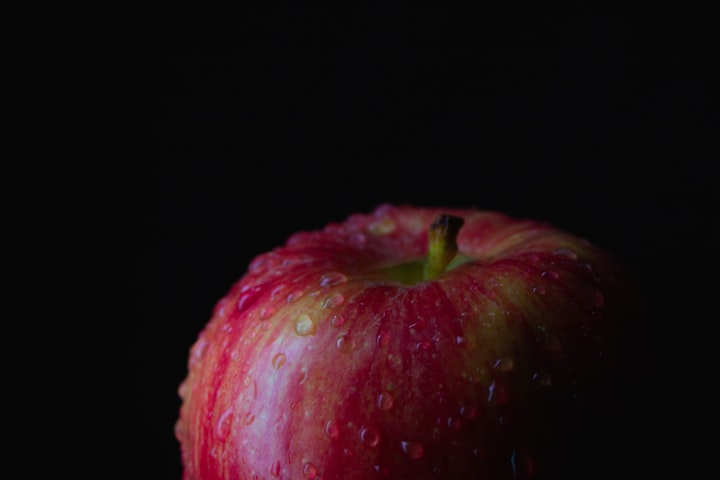
1. Germination: The process begins with the collection and planting of apple tree seeds. The seeds are placed in a damp and nutrient-rich environment, such as potting soil or a seed-starting mix. The seeds need moisture, proper temperature, and oxygen to germinate.
2. Seedling stage: After a few weeks, the apple seeds will start to sprout. At this stage, the emerging plant is referred to as a seedling. The seedling will develop a root system and its first set of leaves called "cotyledons."
3. Growth: As the apple tree seedling continues to grow, it develops more leaves and stems. The roots also continue to expand and anchor the plant in the soil. The seedling now undergoes photosynthesis, generating energy from sunlight.
4. Vegetative growth: The seedling grows into a young apple tree, known as a sapling. During this stage, the plant grows taller and develops branches.
5. Flowering: After reaching a certain size and maturity, the apple tree enters the flowering stage. Flower buds develop on the branches, and they will eventually open into blossoms.
6. Pollination: In order for the apple tree to bear fruit, pollination must occur. Either wind or insects (like bees) help transfer pollen from the male parts of one flower to the female parts of another. This transfer fertilizes the ovules and allows fruit to develop.
7. Fruit development: Once pollination occurs, the fertilized flowers produce fruit. Initially, the fruits are very small and green. As the fruit grows, it accumulates nutrients and water from the soil. It changes color from green to the specific apple variety's characteristic color.
8. Ripening: Over time, the apples continue to grow and mature on the tree. They increase in size and develop the desired taste, texture, and color. The apples are considered ripe when they are easily detached from the tree.
9. Harvesting: The ripe apples are carefully handpicked or harvested using specialized machinery. They are sorted by size, color, and quality.
10. Consumption or storage: The harvested apples can now be eaten fresh or used for various culinary purposes. Apples can also be stored for an extended period if properly stored at the right temperature and humidity conditions.1. Germination: The process begins with the collection and planting of apple tree seeds. The seeds are placed in a damp and nutrient-rich environment, such as potting soil or a seed-starting mix. The seeds need moisture, proper temperature, and oxygen to germinate.
2. Seedling stage: After a few weeks, the apple seeds will start to sprout. At this stage, the emerging plant is referred to as a seedling. The seedling will develop a root system and its first set of leaves called "cotyledons."
3. Growth: As the apple tree seedling continues to grow, it develops more leaves and stems. The roots also continue to expand and anchor the plant in the soil. The seedling now undergoes photosynthesis, generating energy from sunlight.
4. Vegetative growth: The seedling grows into a young apple tree, known as a sapling. During this stage, the plant grows taller and develops branches.
5. Flowering: After reaching a certain size and maturity, the apple tree enters the flowering stage. Flower buds develop on the branches, and they will eventually open into blossoms.
6. Pollination: In order for the apple tree to bear fruit, pollination must occur. Either wind or insects (like bees) help transfer pollen from the male parts of one flower to the female parts of another. This transfer fertilizes the ovules and allows fruit to develop.
7. Fruit development: Once pollination occurs, the fertilized flowers produce fruit. Initially, the fruits are very small and green. As the fruit grows, it accumulates nutrients and water from the soil. It changes color from green to the specific apple variety's characteristic color.
8. Ripening: Over time, the apples continue to grow and mature on the tree. They increase in size and develop the desired taste, texture, and color. The apples are considered ripe when they are easily detached from the tree.
9. Harvesting: The ripe apples are carefully handpicked or harvested using specialized machinery. They are sorted by size, color, and quality.
10. Consumption or storage: The harvested apples can now be eaten fresh or used for various culinary purposes. Apples can also be stored for an extended period if properly stored at the right temperature and humidity conditions.1. Germination: The process begins with the collection and planting of apple tree seeds. The seeds are placed in a damp and nutrient-rich environment, such as potting soil or a seed-starting mix. The seeds need moisture, proper temperature, and oxygen to germinate.
2. Seedling stage: After a few weeks, the apple seeds will start to sprout. At this stage, the emerging plant is referred to as a seedling. The seedling will develop a root system and its first set of leaves called "cotyledons."
3. Growth: As the apple tree seedling continues to grow, it develops more leaves and stems. The roots also continue to expand and anchor the plant in the soil. The seedling now undergoes photosynthesis, generating energy from sunlight.
4. Vegetative growth: The seedling grows into a young apple tree, known as a sapling. During this stage, the plant grows taller and develops branches.
5. Flowering: After reaching a certain size and maturity, the apple tree enters the flowering stage. Flower buds develop on the branches, and they will eventually open into blossoms.
6. Pollination: In order for the apple tree to bear fruit, pollination must occur. Either wind or insects (like bees) help transfer pollen from the male parts of one flower to the female parts of another. This transfer fertilizes the ovules and allows fruit to develop.
7. Fruit development: Once pollination occurs, the fertilized flowers produce fruit. Initially, the fruits are very small and green. As the fruit grows, it accumulates nutrients and water from the soil. It changes color from green to the specific apple variety's characteristic color.
8. Ripening: Over time, the apples continue to grow and mature on the tree. They increase in size and develop the desired taste, texture, and color. The apples are considered ripe when they are easily detached from the tree.
9. Harvesting: The ripe apples are carefully handpicked or harvested using specialized machinery. They are sorted by size, color, and quality.
10. Consumption or storage: The harvested apples can now be eaten fresh or used for various culinary purposes. Apples can also be stored for an extended period if properly stored at the right temperature and humidity conditions.






Comments
Maryann is not accepting comments at the moment
Want to show your support? Send them a one-off tip.